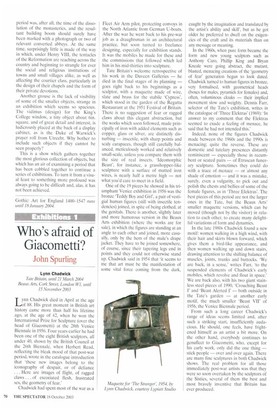Who's afraid of Giacometti?
John Spurling
Lynn Chadwick Tate Britain, until 21 March 2004 BeataArts, Cork Street, London WI, until 15 November 2003 Lyonn Chadwick died in April at the age f 88. His great moment in British art history came more than half his lifetime ago, at the age of 42, when he won the International Prize for Sculpture (over the head of Giacometti) at the 28th Venice Biennale in 1956. Four years earlier he had been one of the eight British sculptors, all under 40, shown by the British Council at the 26th Biennale, when Herbert Read, reflecting the bleak mood of that post-war period, wrote in the catalogue introduction that 'these new images belong to the iconography of despair, or of defiance . . . Here are images of flight, of ragged claws .. . of excoriated flesh, frustrated sex, the geometry of fear.'
Chadwick had spent most of the war as a Fleet Air Arm pilot, protecting convoys in the North Atlantic from German U-boats. After the war he went back to his pre-war job as a draughtsman in an architectural practice, but soon turned to freelance designing, especially for exhibition stands. It was the mobiles he made for these and the commissions that followed which led him in his mid-thirties into sculpture.
Tate Britain's welcome retrospective of his work in the Duveen Galleries — he died in the final stages of its planning — goes right back to his beginnings as a sculptor, with a =queue made of wire, slate and brass for the stabile 'Cypress', which stood in the garden of the Regatta Restaurant at the 1951 Festival of Britain. There is no suggestion of fear or ragged claws about this elegant abstraction, but the works which soon followed, made principally of iron with added elements such as copper, glass or silver, are distinctly disturbing — insectile. with sharp points and scaly carapaces, though still carefully balanced, meticulously worked and relatively small-scale, unless you compare them with the size of real insects. 'Ideomorphic Beast', for instance, a grasshopper-like sculpture with a surface of matted iron wires, is nearly half a metre high — not what you'd care to meet in a field.
One of the 19 pieces he showed in his triumphant Venice exhibition in 1956 was the bronze 'Teddy Boy and Girl', a pair of vestigial human figures (still with insectile tendencies) joined, in spite of being clothed, at the genitals. There is another, slightly later and more humorous version in the Beaux Arts exhibition (where the works are for sale), in which the figures are standing at an angle to each other and joined, more casually, only by the hem of the male's drape jacket. They have to be joined somewhere, of course, since their tapering legs end in points and they could not otherwise stand up. Chadwick said in 1954 that 'it seems to me that art must be the manifestation of some vital force coming from the dark, caught by the imagination and translated by the artist's ability and skill', but as he got older he preferred to dwell on the exigencies of the craft and its materials than on any message or meaning.
In the 1960s, when pure form became the form and new young sculptors such as Anthony Caro, Phillip King and Bryan Kneale were going abstract, the mutant, blasted, menacing creations of the 'geometry of fear' generation began to look dated. Chadwick turned to human figures in bronze, very formalised, with geometrical heads (boxes for males, pyramids for females) and, often, voluminous cloaks — their implied movement slow and weighty. Dennis Farr, selector of the Tate's exhibition, writes in the catalogue of 'Three Elektras' (1969): 'In answer to my comment that the Elektras seemed to exude a feeling of menace, he said that he had not intended this.'
Indeed, none of the figures Chadwick made between the 1960s and the 1990s is menacing; quite the reverse. These are domestic and tutelary presences distantly reminiscent — especially those in recumbent or seated pairs — of Etruscan funerary sculpture. Sometimes they could do with a trace of menace — or almost any shade of emotion — and it was a mistake, surely, even a vulgarity, to pick out and polish the chests and bellies of some of the female figures, as in 'Three Elektras'. The best pieces of this period are not the larger ones in the Tate, but the Beaux Arts' smaller maquette versions, which can be moved (though not by the visitor) in relation to each other, to create many delightful variations of form and dynamics.
In the late 1980s Chadwick found a new motif: women walking in a high wind, with their hair and skirts blown forward, which gives them a bird-like appearance, and then women walking up and down stairs, drawing attention to the shifting balance of muscles, joints, trunks and buttocks. 'We are back, in a sense,' writes Farr, `to the suspended elements of Chadwick's early mobiles, which revolve and float in space.' We are back also, with his two giant stainless steel pieces of 1990. 'Crouching Beast I' and 'Beast Alerted I' — both outside in the Tate's garden — at another early motif, the much smaller 'Beast VII' of 1956, the Venice Biennale period.
From such a long career Chadwick's range of ideas seems limited and, after such a striking start, insufficiently audacious. He should, one feels, have frightened himself as an artist a bit more. On the other hand, everybody continues to genuflect to Giacometti, who, except for his early work, only did the one thing — stick people — over and over again. There are many fine sculptures in both Chadwick shows. The real problem for all those immediately post-war artists was that they were so soon overtaken by the sculptors of the Sixties, several of them the best and most bravely inventive that Britain has ever produced.


































































































 Previous page
Previous page